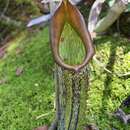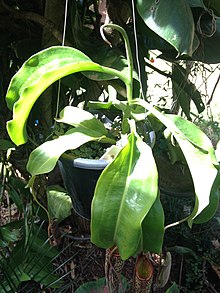pt-BR
nomes no trilho de navegação


Nepenthes maxima ist eine fleischfressende Pflanze aus der Gattung der Kannenpflanzen (Nepenthes). Sie ist heimisch in Teilen Indonesiens und Neuguinea.
Nepenthes maxima sind epiphytisch oder terrestrisch, strauchig oder kletternd wachsende, ausdauernde Pflanzen, die eine Wuchshöhe von bis zu 4 Metern erreichen. Der im Querschnitt zylindrische bis dreieckige, 3 bis 10 Millimeter dicke, dicht flaumig rotbraun behaarte Stängel weist häufig zwei, gelegentlich vier geflügelte Winkel auf, die bis zu 2,5 Millimeter breit sind. Die Internodien sind 5 bis 12 Zentimeter lang, die deutlich sichtbaren Achselknospen stachelartig.[1]
Die dicht flaumig rotbraun behaarten Blattstiele von Nepenthes maxima sind rinnenförmig und schmal geflügelt, bis zu 7 Zentimeter lang, die Flügel sind am Ansatz zu einer Scheide verbreitert. Die Spreite (eigentlich ein umgebildeter Blattgrund, strenggenommen ist erst die Kanne die Spreite) ist ledrig, 15 bis 30 Zentimeter lang und 2,5 bis 7 Zentimeter breit und umgekehrt-eiförmig bis lanzettlich, am äußeren Ende abgerundet bis spitz zulaufend. Parallel zur dicht flaumig rotbraun behaarten Mittelrippe verlaufen auf jeder Hälfte der Spreite in deren äußerem Drittel bis Viertel ein bis drei schwach ausgeprägte Längsrippen, nicht zu verwechseln mit den stark ausgeprägten, in regelmäßigen Abständen auftretenden Rillen auf der oberen Blattoberfläche. Die zahlreichen, nicht parallel verlaufenden Seitenrippen sind häufig verzweigt und nur schwach ausgeprägt. Der Blattrand ist dicht flaumig rotbraun behaart.[1]
Wie bei Kannenpflanzen häufig, weisen die Kannen von Nepenthes maxima einen deutlichen Dimorphismus auf, die unteren, bodennah wachsenden Kannen und die höheren, sogenannten Luftkannen unterscheiden sich also hinsichtlich Form und Größe. Nepenthes maxima gilt dabei als sehr variable Art, insbesondere die Gestalt der oberen Kannen reicht von schmal zylindrisch bis stark trompetenförmig, bei manchen Populationen sind sie ähnlich wie die unteren Kannen über ihre ganze Länge hin geflügelt.[1]
Die unteren Kannen sind entweder schmal eiförmig, nach oben hin zylindrisch werdend und gelegentlich tailliert oder zur Gänze annähernd zylindrisch bis zylindrisch-ellipsoid, sie erreichen eine Länge von 8 bis 20 Zentimeter und einen Durchmesser von 2,2 bis 5 Zentimeter. Ihre beiden Flügel sind bis zu 8 Millimeter breit und mit bis zu 6 Millimeter langen Fransen besetzt, die in Abständen von 1 bis 4 Millimeter zueinander stehen. Die Kannenöffnung ist eiförmig und konkav, das Peristom vorn annähernd zylindrisch und 2 bis 5 Millimeter breit, zum Deckelansatz hin abflachend und auf bis zu 15 Millimeter sich verbreiternd. Der äußere Rand ist einfach bis schwach gewellt, der innere gezähnt; die deutlich ausgeprägten Rippen stehen in Abständen von 0,25 bis 1 Millimeter zueinander. Der Kannendeckel ist eiförmig, rund 2,5 Zentimeter lang und ebenso breit, am äußeren Ende ist er abgerundet, am Ansatz herzförmig, auf der Unterseite trägt er zwei Anhängsel, das dem Ansatz zugewandte ist seitlich abgeflacht und hakenförmig zum Ansatz hin gekrümmt, das dem äußeren Ende nähere Anhängsel ist meist fadenförmig und bis zu 12 Millimeter lang, kann jedoch selten auch zu einer unauffälligen Verdickung reduziert sein. Nektardrüsen finden sich hier vereinzelt bis dicht, zumeist um die Mittelrippe, gelegentlich hin bis zu den Anhängseln. Der ganzrandige Sporn ist fadenförmig und bis zu 6 Millimeter lang.[1]
Wie alle Vertreter der Gattung ist auch Nepenthes maxima zweihäusig getrenntgeschlechtig (diözisch), eine Pflanze besitzt also entweder nur männliche, oder nur weibliche Blüten. Die vom Ansatz bis zur Unterseite der Blütenhüllblätter dicht flaumig rotbraun behaarten männlichen Blütenstände sind 16 bis 19, selten bis zu 40 Zentimeter lang, der Blütenstängel 5,5 bis 8, selten bis 14 Zentimeter lang und haben am Ansatz einen Durchmesser von 1,25 bis 1,5 Zentimeter. Von diesem ab gehen dann rund 85 2 bis 4, selten bis 5 Millimeter lange Teilblütenstände, die in der Regel zwei Blüten tragen. Die linealischen Tragblätter sind zurückgebogen, rund 2,5 Millimeter lang und setzen 0 bis 2 Millimeter unterhalb der Teilblütenstände an. Die eigentlichen Blütenstiele sind 6 bis 9, selten bis 16 Millimeter lang. Die Blütenhüllblätter sind elliptisch, dunkelrot, 3 bis 4,5 Millimeter lang und 1,5 bis 2,5, selten bis 3,5 Millimeter breit. Das flaumig behaarte Androphor ist 2,5 bis 4 Millimeter lang.[1]
Nepenthes maxima kommt in Sulawesi, auf den Molukken bis nach Neuguinea in Höhenlagen zwischen 600 und 2500 Metern (gelegentlich auch in niedrigeren Höhenlagen bis zu 40 Metern[2]) vor. Die Pflanzen siedeln als Epiphyt in moosigen Wäldern, terrestrisch in sumpfigem Grasland, auf Felsgraten, in offenen Wäldern auf weißem Sand und auf metallhaltigen, ultramafischen Böden.[1]
Nepenthes maxima wurde 1824 vom deutschen Botaniker Caspar Georg Carl Reinwardt erstbeschrieben. Das Art-Epitheton bedeutet so viel wie „die Größte“ und verweist auf das stattliche Erscheinungsbild der Pflanzen[3].
Als nächstverwandt innerhalb der Gattung gelten Nepenthes klossii, Nepenthes fusca und Nepenthes eymae.[1]
Nepenthes maxima ist eine fleischfressende Pflanze aus der Gattung der Kannenpflanzen (Nepenthes). Sie ist heimisch in Teilen Indonesiens und Neuguinea.

Nepenthes maxima (/nɪˈpɛnθiːz ˈmæksɪmə/; from Latin: maximus "greatest"), the great pitcher-plant,[5] is a carnivorous pitcher plant species of the genus Nepenthes. It has a relatively wide distribution covering New Guinea, Sulawesi, and the Maluku Islands.[6] It may also be present on Wowoni Island.[7]
Nepenthes maxima belongs to the loosely defined "N. maxima complex", which also includes, among other species, N. boschiana, N. chaniana, N. epiphytica, N. eymae, N. faizaliana, N. fusca, N. klossii, N. platychila, N. stenophylla, and N. vogelii.[8]
This species exhibits great variability across its range, particularly in the plasticity of its pitchers.[9] Plants growing in drier, somewhat seasonal parts of New Guinea generally produce elongated pitchers with narrow peristomes and well-developed waxy zones, while those inhabiting perhumid areas often have a reduced waxy zone and enlarged peristome. This is thought to be because the peristome, when fully wetted, is more effective at trapping prey than the waxy zone, but performs poorly in drier conditions.[10][11]
Certain forms of N. maxima produce distinctly wavy laminar margins, a trait particularly common in plants from Sulawesi.[6][12] In extreme examples, even the decurrent wings of the leaf—which can extend down the entire length of the stem's internode—may be highly undulate.[13] Such rippled patterns result from increased cell growth near the edges of the leaf, which causes its thin, planar surface to buckle as it assumes the conformation with the lowest energy state.[14]
In 2009, a cultivar from Lake Poso in Sulawesi was named Nepenthes maxima 'Lake Poso'.[15] In 2016, this taxon was described as a species in its own right, N. minima.[16]
 An upper pitcher of a plant matching the description of N. oblanceolata, which is sometimes regarded as a synonym of N. maxima
An upper pitcher of a plant matching the description of N. oblanceolata, which is sometimes regarded as a synonym of N. maxima  A rosette plant of N. oblanceolata from near Wamena, Baliem Valley, New Guinea
A rosette plant of N. oblanceolata from near Wamena, Baliem Valley, New Guinea  Male inflorescence
Male inflorescence  Infructescence
Infructescence Nepenthes maxima (/nɪˈpɛnθiːz ˈmæksɪmə/; from Latin: maximus "greatest"), the great pitcher-plant, is a carnivorous pitcher plant species of the genus Nepenthes. It has a relatively wide distribution covering New Guinea, Sulawesi, and the Maluku Islands. It may also be present on Wowoni Island.
Nepenthes maxima belongs to the loosely defined "N. maxima complex", which also includes, among other species, N. boschiana, N. chaniana, N. epiphytica, N. eymae, N. faizaliana, N. fusca, N. klossii, N. platychila, N. stenophylla, and N. vogelii.
Nepenthes maxima adalah tumbuhan karnivora dalam famili Nepenthaceae atau keluarga kantong semar. Nepenthes maxima tumbuh tersebar di Pulau Sulawesi, Kepulauan Maluku, dan Pulau Papua (0 – 2000 m dari permukaan laut)[1].
Nepenthes maxima adalah tumbuhan karnivora dalam famili Nepenthaceae atau keluarga kantong semar. Nepenthes maxima tumbuh tersebar di Pulau Sulawesi, Kepulauan Maluku, dan Pulau Papua (0 – 2000 m dari permukaan laut).
Nepenthes maxima Reinw. ex Nees, 1824 è una pianta carnivora della famiglia delle Nepenthaceae.[2]
È diffusa in Nuova Guinea, Sulawesi) e nelle isole Molucche[1].
Recentemente è stata segnalata anche nella catena del monte Hamiguitan, nelle Filippine meridionali (Mindanao)[3].
Cresce come epifita nella foresta nebulosa o terrestre nei campi paludosi, ad altitudini comprese tra 600 e 2500 m[1].
Nepenthes maxima Reinw. ex Nees, 1824 è una pianta carnivora della famiglia delle Nepenthaceae.
A espécie Nephenthes maxima é uma espécie de planta pertencente ao gênero Nepenthes. Ela apresenta os ascídios rajados com tons de vermelho e verde quando lower e intermediário, sendo que quando atingem o estágio "adulto" ou upper os ascídios tendem a se tornar verdes. Esta característica evolutiva permite que planta quando jovem e próximo ao solo capture os insetos daquele nicho, e quando atinge uma idade mais avançada estará se agarrando a plantas mais altas, tendendo a predar insetos de altitude superior.[1]
 Nephenthes maxima ao sol
Nephenthes maxima ao sol  Ascideos intermediários da Nephenthes maxima
Ascideos intermediários da Nephenthes maxima A espécie Nephenthes maxima é uma espécie de planta pertencente ao gênero Nepenthes. Ela apresenta os ascídios rajados com tons de vermelho e verde quando lower e intermediário, sendo que quando atingem o estágio "adulto" ou upper os ascídios tendem a se tornar verdes. Esta característica evolutiva permite que planta quando jovem e próximo ao solo capture os insetos daquele nicho, e quando atinge uma idade mais avançada estará se agarrando a plantas mais altas, tendendo a predar insetos de altitude superior.